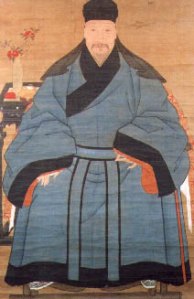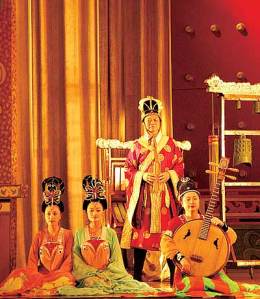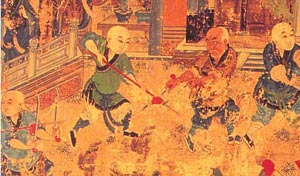The Tang dynasty had many great things about it. If I had to pick 5 of them, my list would be Painting, Music, Martial Arts, Sculpture, and Buddhism (Buddhism being the most interesting to me).
There were many kinds of painting styles that emerged during the early Chinese civilization years. In the Tang dynasty, there were two main types of painting styles. The Tang began with figure painting being a really popular method. First appearing during the neolithic period, figure painting was usually seen on poetry, however, it spread rapidly t0 tiles, tombs, cave walls, and even family shrines (yes, families had their own shrines)! Although figure painting was popular and enjoyed by many, towards the end of the Tang dynasty, it lost its momentum to the rise of landscape painting, which was considered the height of achievement by the academy painters and the literati. (Although landscape painting sort of abruptly took over, figure painting has had a long run. For a more in-depth article on it, check out this blog). When non-Chinese folks often think about Chinese paintings, they usually don’t think of figure painting, but instead they imagine a painting with rollings hills, large fields, maybe some birds and flowers in the springtime. Landscape paintings have had such a large influence on both the Chinese and the world around them.
civilization years. In the Tang dynasty, there were two main types of painting styles. The Tang began with figure painting being a really popular method. First appearing during the neolithic period, figure painting was usually seen on poetry, however, it spread rapidly t0 tiles, tombs, cave walls, and even family shrines (yes, families had their own shrines)! Although figure painting was popular and enjoyed by many, towards the end of the Tang dynasty, it lost its momentum to the rise of landscape painting, which was considered the height of achievement by the academy painters and the literati. (Although landscape painting sort of abruptly took over, figure painting has had a long run. For a more in-depth article on it, check out this blog). When non-Chinese folks often think about Chinese paintings, they usually don’t think of figure painting, but instead they imagine a painting with rollings hills, large fields, maybe some birds and flowers in the springtime. Landscape paintings have had such a large influence on both the Chinese and the world around them.
During the Tang dynasty, the city of Xi’an was the largest city and a place where foreign influence assimilated over time. The Tang dynasty’s music is said to have western influences, something that had not been seen, or more like heard, before. This song is one example of music from the Tang dynasty. Listening to this made me really feel like I was back in imperial China, walking up to the court steps, about to meet the ruler. The song, if you listen carefully with your eyes closed, sort of sounds like it is telling a story, a sort of progressive piece. Although the Tang dynasty’s music is said to have western influences on it, the music is distinctly Chinese, with roots in Confucian harmony.
influence assimilated over time. The Tang dynasty’s music is said to have western influences, something that had not been seen, or more like heard, before. This song is one example of music from the Tang dynasty. Listening to this made me really feel like I was back in imperial China, walking up to the court steps, about to meet the ruler. The song, if you listen carefully with your eyes closed, sort of sounds like it is telling a story, a sort of progressive piece. Although the Tang dynasty’s music is said to have western influences on it, the music is distinctly Chinese, with roots in Confucian harmony.
Everyone has heard of Kung Fu, Karate, and Judo, but can you explain the origin? To be honest, no one can. Martial Arts is too remote to identify to one exact place, but we can trace it back to a certain era. Martial Arts picked up during the Han Dynasty, a period known for its political, economic, and social development. For the first years of the art, it was done with bare hands. But then the idea of controlled weaponry came into play, and The Tang really honored the martial arts. In this period, we see the modification of the weapons and better, clearer demonstrations of new and old techniques. Soldiers with outstanding martial art skill were honored with commendation and titles, encouraging the skill set to pick up amongst ordinary people. This page has more in detailed explanations of the early origins and later advancements.
trace it back to a certain era. Martial Arts picked up during the Han Dynasty, a period known for its political, economic, and social development. For the first years of the art, it was done with bare hands. But then the idea of controlled weaponry came into play, and The Tang really honored the martial arts. In this period, we see the modification of the weapons and better, clearer demonstrations of new and old techniques. Soldiers with outstanding martial art skill were honored with commendation and titles, encouraging the skill set to pick up amongst ordinary people. This page has more in detailed explanations of the early origins and later advancements.

Sculpture was something that began to develop during the Sui dynasty. However, during the Tang dynasty was when the art of sculpting really reached its height. Sculptors usually emphasized on using graceful lines and sharp, clear forms, and good proportions. The heads were the right size for the bodies, as well as the arms and legs. Symbolic sculpting wasn’t really as popular back then as it is now.
Buddhism was something that was prevalent in the early Tang dynasty. However, towards the peak of the dynasty, Buddhism declined and Confucianism became popular. Although Buddhism was at its peak during the early Tang, most of the Tang officials were Confucian disciples and thought that Buddhism was a disruptive force in China. The persecution of Buddhists was carried out by the Tang emperor in 845, and thousands of structures were destroyed (such as shrines and monasteries). During this time, other religions were also brought under government control.